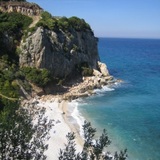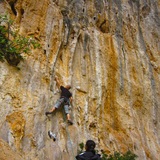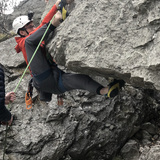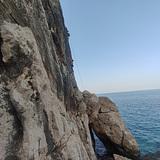🧗♀️⛰ The canyon that starts from Cala Fuili is where you will spend most of your time once in Cala Gonone. The walls of the canyon offer a completely different style from other sectors in Cala Gonone, where what you get is mostly leaning slabs. Our best advice is to go there as soon as you lay your first step in Cala Gonone, don't waste time. There are plenty of crags along the canyon, and you will definitely find one that suits your skills. The atmosphere is that of a place lost in time, so remote from any form of civilization that you wish you could live here like a caveman (hoping they had harnesses and ropes).
Upon arriving at Cala Fuili you will be shocked by the beauty of this tiny cove, surrounded by walls. Descending the stairs to the beach there's the first crag, equipped with easy routes for children. Down at the beach, 3 more crags are equipped with routes ranging from 5b to 6b, easy peasy. Hiding on the southern end of the beach, a cave hosts a few overhangs (which unfortunately are too rusty to be climbed). But is through the canyon that the most challenging sectors are waiting for your shoes to climb them.
Local climbers can't have enough of sectors such as "Raoni", "Pederiva" and "Thailandia". Pederiva and Thailandia have awesome routes on overhangs and tufas and are best in the winter months. On the other hand, Raoni is always in the shade, and if there's not too much humidity in the air, you can enjoy it even during the hottest summer days.
☀🌡WHAT CAN I CLIMB DURING THE SUMMER?
If you like waking up early, you may lay your hands on the routes at "Tribuna" or "Zedda Piras". But just because no climber on holiday wants (or can) wake up early enough (what kind of holiday would that be otherwise?), it is best to wait for the afternoon, when the shade falls upon the sectors Spigolo (2 pm), Tritoni (2 pm) or Scalini (5 pm). Anyhow, consider that if the scirocco wind is blowing with its load of humidity, the rock gets damp with sea salt, making it as greasy as a slice of bacon.








